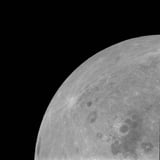Meteorites Key in Crafting Moon's Thin Atmosphere, New Study Reveals
August 2, 2024
New research reveals that meteorite impact vaporization is the primary process responsible for creating the Moon's atmosphere, known as the exosphere.
A study published today in Science Advances investigates how the exosphere is continuously replenished with atoms, particularly focusing on alkali metals.
The Moon's surface has been subjected to constant bombardment by meteorites and micrometeoroids over its 4.5-billion-year history, resulting in visible craters.
Lead author Nicole Nie emphasizes that meteorite impact vaporization creates a steady state atmosphere, replenished by ongoing impacts.
The findings indicate that approximately 70% of the lunar exosphere is generated by meteorite impacts, while the remaining 30% results from solar wind and ion sputtering.
The lunar atmosphere primarily consists of argon, helium, neon, potassium, and rubidium, extending up to about 100 kilometers above the surface.
Despite being classified as an exosphere, the Moon's atmosphere is extremely thin, with atoms too sparse to collide, unlike Earth's denser atmosphere.
The study utilizes lunar soil samples from the Apollo program to analyze isotopic ratios, revealing insights into the processes that contribute to the lunar atmosphere.
Advancements in technology are enabling scientists to address previously unresolved questions about the Moon's atmosphere.
NASA's Lunar Atmosphere and Dust Environment Explorer (LADEE) highlighted the roles of impact vaporization and solar wind in shaping the lunar atmosphere.
This significant research was published in the journal Science Advances today, marking a step forward in our understanding of lunar atmospheric dynamics.
Summary based on 8 sources
Get a daily email with more Science stories
Sources

The Guardian • Aug 2, 2024
Meteorite impacts produce most of moon’s thin atmosphere, study reveals
Yahoo News • Aug 2, 2024
Meteorite impacts identified as driver of moon's tenuous atmosphere
ScienceDaily • Aug 2, 2024
Scientists pin down the origins of the moon's tenuous atmosphere
Phys.org • Aug 2, 2024
Scientists pin down the origins of the moon's tenuous atmosphere